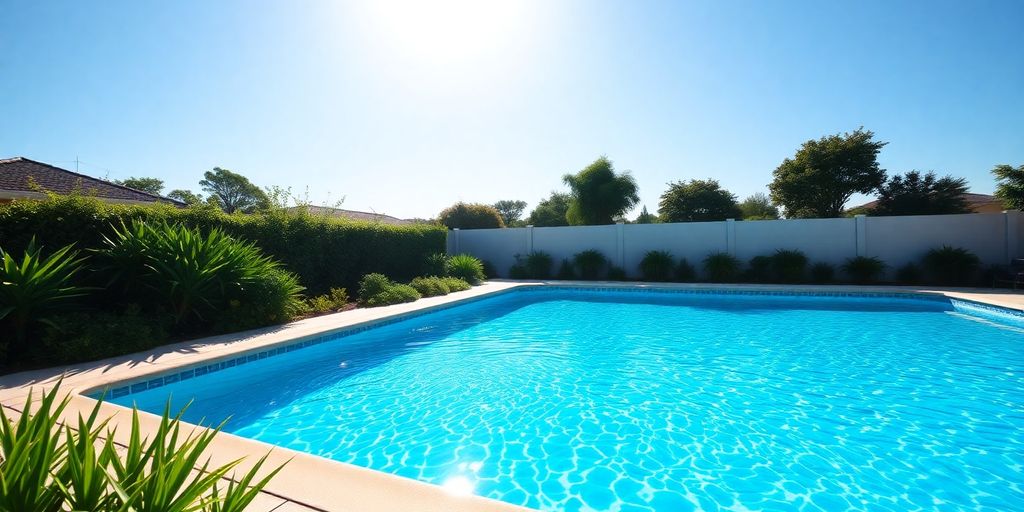G’day, fellow pool owners! If you’re keen to keep your backyard oasis sparkling clean without too much fuss, you’ve come to the right place. We’re gonna chat about how to keep your pool in tip-top shape, making sure the maintenance of a swimming pool is a breeze. It’s not as hard as you might think, and once you get the hang of it, you’ll be wondering why you didn’t start sooner. Let’s get stuck in and make that pool shine!
Key Takeaways
- Regularly looking after your pool makes it stay clean and inviting.
- Picking the right tools for the job makes a big difference.
- Getting your pool ready before you start cleaning saves headaches.
- A steady approach to cleaning gets the best results.
- Always look after your gear after each use.
Why Regular Maintenance Of A Swimming Pool Is Crucial

Keeping your pool clean isn’t just about aesthetics; it’s about making sure your backyard oasis is safe, healthy, and ready for a dip whenever the Aussie sun is shining. Neglecting regular maintenance can lead to a whole host of problems, from murky water to costly repairs. Let’s dive into why staying on top of your pool care is so important.
Simple And Efficient Cleaning
Using a pool vacuum, especially a manual one, gives you direct control over the cleaning process. You can target those tricky spots where leaves and gunk tend to gather, like corners or steps, that an automatic cleaner might miss. It’s a straightforward way to get your pool looking schmick without too much fuss. You just hook it up, and off you go, sucking up all the bits and pieces that have settled on the bottom. It’s a bit like using a regular vacuum cleaner in your house, but for your pool. Plus, you don’t have to worry about complicated programming or sensors playing up.
Built To Last For Aussie Conditions
Our Aussie weather can be pretty harsh, right? Blazing sun, sudden downpours, and all sorts of debris can take a toll on your pool. Regular maintenance helps protect your pool’s surfaces and equipment from the elements. Think of it as giving your pool a fighting chance against the harsh Aussie climate. By keeping on top of things, you’ll extend the life of your pool and avoid expensive repairs down the track.
Improved Water Quality For A Sparkling Pool
Regular maintenance isn’t just about removing leaves and debris; it’s also about maintaining the right water chemistry. Imbalanced water can lead to algae growth, cloudy water, and skin irritation. Nobody wants to swim in a swamp! By regularly testing and adjusting your pool’s water, you can ensure it’s clean, clear, and safe for everyone to enjoy. This includes checking pH, alkalinity, and chlorine levels. A pool maintenance routine is essential for keeping your pool water in top condition.
Think of your pool as an investment. Just like you wouldn’t neglect servicing your car, you shouldn’t neglect maintaining your pool. Regular maintenance not only keeps your pool looking great but also protects your investment and ensures years of enjoyment.
Selecting The Right Gear For Pool Maintenance
Alright, so you’re ready to get serious about keeping your pool clean. That means getting the right gear. It’s not just about grabbing the cheapest stuff; it’s about investing in tools that will last and make the job easier. Trust me, your back (and your pool) will thank you for it.
Effortless Debris Removal
Let’s talk about the basics. You’ll need a decent leaf rake or skimmer net. Look for one with a sturdy frame and a fine mesh to catch even the smallest bits of debris. You don’t want to be chasing leaves around the pool all day. A good skimmer will make quick work of surface debris, keeping your pool looking inviting. Think of it as your first line of defence against the Aussie bush.
Durable Materials For Longevity
When it comes to pool gear, you get what you pay for. Cheap plastic will crack and fade in the sun, leaving you back at the shops sooner than you’d like. Invest in equipment made from durable, UV-resistant materials. Things like aluminium poles, reinforced nets, and quality hoses will stand up to the harsh Aussie conditions. It’s a bit like buying a good pair of work boots – they might cost a bit more upfront, but they’ll last for years.
Choosing The Right Vacuum Head
Now, for the main event: the pool vacuum. There are a few options here, from manual vacuums to automatic pool cleaners. Manual vacuums are great for targeted cleaning, especially in those hard-to-reach spots. Automatic vacuums, on the other hand, can do the job for you, saving you time and effort. When choosing a vacuum head, consider the size and shape of your pool. A wider head will cover more area, but a smaller head might be better for tight corners. Also, think about the type of surface you have. Some vacuum heads are better suited for concrete pools, while others are designed for vinyl liners.
Getting the right gear is half the battle. Don’t skimp on quality, and make sure you choose tools that are suited to your pool and your cleaning style. A little bit of research upfront can save you a lot of headaches down the road.
Prepping Your Pool For A Pristine Clean
Before you even think about dunking that vacuum head in, there’s some groundwork to do. Think of it like getting the barbie ready before chucking on the snags – a bit of effort now saves a whole lot of grief later. Getting everything sorted before you start vacuuming is key to a smooth, effective clean.
Gather Your Cleaning Kit
First things first, round up all your gear. You don’t want to be halfway through and realise you’ve left your pole on the other side of the yard. Here’s what you’ll need:
- Your trusty pool vacuum head (the one you picked out earlier, remember?)
- A telescopic pole, long enough to reach every nook and cranny
- Your pool hose – make sure it’s free of kinks and holes
- A skimmer box vacuum plate (if you’re using one)
- A pool brush, for those stubborn bits
It’s a bit like getting ready for a road trip; you wouldn’t just jump in the car without checking the fuel and tyres, would ya? Same goes for pool cleaning. A quick check of your kit means no mid-job dramas.
Check Your Pool’s Water Level
This one’s a ripper. Before you start, have a squiz at your pool’s water level. It needs to be at the right height for your skimmer to work properly and for your pump to get a good prime. If it’s too low, you risk sucking air into your system, which is a real pain in the backside and can damage your pump. If it’s a bit low, top it up with the garden hose. Easy as that. Maintaining the correct water level is important for the pool’s health.
Brush Down The Pool Walls
Alright, this is where you get a bit of a workout. Grab your pool brush and give the walls and floor a good scrub. This knocks any loose dirt and algae off the surfaces and into the water column, making it easier for your vacuum to suck it all up. Think of it as loosening the dirt before you sweep the floor inside. Pay extra attention to those shady spots where algae loves to hang out. For those really stubborn bits, a bit of elbow grease might be needed.
Mastering The Pool Vacuuming Technique
Alright, cobber, once you’ve got your gear sorted and the pool’s ready, it’s time to get stuck into the actual vacuuming. It’s not just about pushing the vacuum head around; there’s a bit of a knack to it if you want a truly sparkling result.
Slow And Steady Wins The Race
This isn’t a sprint, mate, it’s a marathon. Moving your pool vacuum head slowly and deliberately is the secret to picking up all that gunk without stirring it up. If you go too fast, you’ll just kick up the dirt and debris, turning your crystal-clear water into a cloudy mess. Then you’ll have to wait for it all to settle again, which is a right pain. Think of it like mowing the lawn – nice, even passes, no rushing.
You want to give the vacuum head time to suck up everything in its path. Patience is a virtue when you’re trying to get your pool looking its best. Don’t be tempted to speed things up, or you’ll just create more work for yourself in the long run.
Overlap Your Strokes For A Thorough Clean
Just like painting a wall or mowing the lawn, you need to overlap your strokes to make sure you don’t miss any spots. Start at one end of the pool, usually the shallow end, and work your way across. Each pass should slightly overlap the previous one. This systematic approach ensures you cover every inch of the pool floor. Using a telescopic pole can help you reach all areas of the pool.
- Begin at the shallow end, working towards the deep end.
- Use long, straight strokes, moving the vacuum head in a consistent direction.
- Overlap each stroke by about a quarter to a third of the vacuum head’s width.
- Pay extra attention to corners and areas where debris tends to settle.
Dealing With Tricky Spots
Sometimes you’ll come across a patch of stubborn gunk that just won’t budge on the first go. Don’t stress, it happens. For these tricky bits, you might need to go over them a couple of times. If it’s really stuck, you can try a slightly firmer, but still slow, push. For effective pool cleaning, regular vacuuming helps prevent buildup.
Here’s a quick guide for tackling different types of debris:
| Debris Type | Recommended Action |
|---|---|
| Fine Silt | Very slow, gentle passes; may require multiple attempts. |
| Leaves | Go over slowly; if large, consider using a leaf skimmer first. |
| Algae Spots | Brush first to loosen, then vacuum slowly. |
Post-Vacuuming Pool Care For Lasting Sparkle
Alright, you’ve done the vacuuming, and the pool’s looking pretty good. But don’t chuck your feet up just yet! There are a few things to do after vacuuming to keep that sparkle going and make sure your gear lasts. It’s like the cool-down after a workout – just as important as the main event.
Backwash Your Philtre Like A Pro
After vacuuming, especially if the pool was a bit rough, your philtre’s probably full of gunk. Backwashing is super important to keep it working properly. Here’s a quick guide:
- Turn off the pump.
- Set the multiport valve to ‘Backwash’.
- Turn the pump back on and let it run for 2-3 minutes, or until the water in the sight glass runs clear.
- Turn off the pump again.
- Set the valve to ‘Rinse’ and run for about 30 seconds.
- Turn off the pump and return the valve to ‘Philtre’.
- Turn the pump back on.
Backwashing gets rid of all the trapped dirt and debris, so your philtre can keep doing its job properly. If you don’t backwash, the philtre can get clogged, which means it won’t clean the water as well, and it can even damage the philtre itself.
Check And Adjust Water Chemistry
Vacuuming can stir things up, so it’s a good idea to check your water chemistry afterwards. Grab your good test kit and test the pH, chlorine, and alkalinity levels. Adjust as needed to keep everything balanced. Here’s a rough guide:
- pH: Should be between 7.2 and 7.8.
- Chlorine: Aim for 1-3 ppm (parts per million).
- Alkalinity: Keep it between 80 and 120 ppm.
If anything’s out of whack, add the appropriate chemicals according to the instructions. Balanced water chemistry not only keeps your pool sparkling but also protects your equipment and keeps swimmers safe.
Clean And Store Your Equipment Properly
Don’t just chuck your vacuum head and hose back in the shed! Give them a good rinse with the hose to get rid of any lingering dirt or chemicals. Let them dry completely before storing them in a cool, dry place. This will help prevent mould and mildew and keep your gear in good nick for longer. Also, coil the hose loosely to avoid kinks and cracks. A little bit of care goes a long way in extending the life of your pool cleaning equipment.
Maintaining Your Pool Cleaning Equipment

You’ve invested in some good quality gear to keep your pool looking schmick, so it makes sense to look after it, right? A little bit of care goes a long way in making sure your pool vacuum head and all its bits and bobs last, saving you some dosh in the long run.
Rinse Your Gear After Each Use
Don’t just chuck your gear back in the shed after you’ve finished vacuuming. Give your vacuum head, hose, and pole a good rinse with fresh water. This washes off any pool chemicals, dirt, and tiny bits of gunk that might be clinging on. If you leave that stuff on, it can corrode the materials over time, especially the metal bits, and make everything brittle. Think of it like hosing down your thongs after a day at the beach – gets rid of the sand, keeps them looking good.
Store In A Shady Spot
The Aussie sun is a real scorcher, but it’s a killer on plastic and rubber. Leaving your pool vacuum gear out in direct sunlight is a surefire way to shorten its lifespan. The UV rays will make the plastic brittle and faded, and the rubber seals and hoses will crack and perish. Find a nice, cool, shady spot to store everything. A shed, a garage, or even under a covered patio is ideal. Just make sure it’s out of the elements.
Keeping your pool cleaning equipment in tip-top shape isn’t just about making it last longer; it’s about making your next cleaning job easier and more effective. A well-maintained vacuum head glides smoothly and picks up debris like a champion, while neglected gear can turn a simple chore into a frustrating battle.
Regularly Inspect For Wear And Tear
It’s a good idea to give your pool vacuum gear a quick once-over every now and then, even if you’re rinsing it after each use. Look for any signs of wear and tear. Are there any cracks in the plastic? Is the hose getting stiff or showing signs of splitting? Are the brushes on your vacuum head worn down? Catching these issues early can save you from bigger problems down the track. Replace worn parts as needed to keep your equipment running smoothly.
Seasonal Maintenance Of A Swimming Pool
Owning a pool in Australia means dealing with some pretty extreme weather. From scorching summers to leafy autumns, each season throws its own challenges at your pool. A seasonal approach to pool maintenance is the best way to keep your Aussie oasis sparkling all year round.
Spring Clean For Summer Readiness
Spring is the time to shake off the winter blues and get your pool ready for some serious summer fun. Here’s what you need to do:
- Full Inspection: Check for any damage caused by the winter months. Look for cracks, leaks, or any wear and tear on your equipment. Get any necessary repairs done ASAP.
- Deep Clean: Give your pool a thorough clean. Vacuum, scrub, and get rid of any algae or debris that’s accumulated over winter. Pay special attention to those hard-to-reach spots.
- Water Chemistry: Get your water balanced. Test and adjust the pH, alkalinity, calcium hardness, and sanitiser levels. This is essential for a clean and safe swimming environment.
Spring cleaning is more than just a quick tidy-up; it’s about setting your pool up for a summer of fun and relaxation. A little effort now will save you headaches later.
Summer Routine For Daily Sparkle
Summer is when your pool gets the most use, so a consistent routine is key. Here’s what to keep on top of:
- Regular Testing: Test your water chemistry at least twice a week. With more people using the pool and the hot sun beating down, things can get out of whack quickly.
- Skimming and Vacuuming: Skim the surface daily to remove leaves, bugs, and other debris. Vacuum at least once a week to keep the floor clean.
- Philtre Maintenance: Clean your philtre regularly. A dirty philtre can reduce water flow and make your sanitiser less effective.
Autumn Prep For Leafy Challenges
Autumn brings falling leaves and cooler temperatures. Here’s how to prepare your pool:
- Leaf Removal: Invest in a good leaf rake or pool cover to keep those pesky leaves out of your pool. They can stain the pool surface and clog your philtre.
- Water Chemistry: Continue to monitor and adjust your water chemistry. Even though you might not be swimming as much, it’s still important to keep things balanced.
- Consider a Winter Cover: If you’re planning on closing your pool for the winter, now’s the time to get a winter cover. This will protect your pool from the elements and make spring clean-up easier.
Winter Care For Off-Season Protection
Winter is the time to give your pool a break. Here’s how to protect it during the off-season:
- Lower Water Level: If you live in an area with freezing temperatures, lower the water level to prevent damage to your pipes and equipment.
- Winterise Equipment: Drain your pump, philtre, and heater to prevent freezing. Add antifreeze to any remaining water in the pipes.
- Cover Your Pool: A good winter cover will protect your pool from debris and the elements. This will make spring clean-up much easier. Remember to maintain your pool maintenance routine even during winter, albeit less frequently.
Wrapping It Up
So, there you have it. Keeping your pool in good shape isn’t some big, complicated thing. It’s just about doing a few regular jobs and knowing what to look for. You don’t need to be a pool guru to keep your backyard looking great. Just stick to these simple ideas, and you’ll have a pool that’s always ready for a dip. It’s all about making things easy so you can spend more time enjoying your own bit of paradise and less time stressing about it. Happy swimming, everyone!
Frequently Asked Questions
Why should I bother vacuuming my pool?
Using your pool vacuum is a top-notch way to keep your swimming spot looking grouse. It’s super simple to use, gets rid of all sorts of muck, and helps keep your water healthy so you don’t need as many chemicals. Plus, our vacuum heads are built tough for the Aussie climate, so they’ll last for ages.
What kind of pool vacuum head should I get?
You’ve got a couple of excellent choices! The ‘True Blue’ vinyl liner vacuum head is perfect for vinyl pools, but it also works a treat on concrete and fibreglass. It’s got brushes to scrub away dirt. Then there’s the ‘Aussie Gold’ flexible vacuum head, which is ace for all pool types, from concrete to tiled. Both are built tough and connect easily to your standard pool gear.
What should I do before I start vacuuming?
Before you get stuck into vacuuming, gather all your bits and pieces: your vacuum head, a long pole, your hose (make sure it’s not kinked!), a skimmer box vacuum plate if you use one, and a pool brush. Also, check your pool’s water level – it needs to be just right. Then, give the pool walls and floor a good scrub to loosen any dirt before you vacuum.
What’s the best way to vacuum my pool?
The main thing is to go slow and steady. If you rush, you’ll just stir up all the dirt and make the water cloudy. Move the vacuum head smoothly across the bottom, overlapping each pass a little bit so you don’t miss any spots. Think of it like mowing the lawn – nice, even rows.
What should I do after I’ve vacuumed my pool?
After you’ve finished vacuuming, it’s a good idea to backwash your philtre. This cleans out all the gunk you’ve just sucked up. Then, check your pool’s chemical levels (like chlorine and pH) and adjust them if needed. Finally, give your vacuum gear a good rinse and store it away properly, out of the sun.
How do I look after my pool cleaning equipment?
Always rinse your pool cleaning gear with fresh water after each use – it’s like giving your ute a quick wash after a trip to the beach. Store everything in a shady spot, as the Aussie sun can be brutal on plastic and rubber. And every now and then, give your gear a quick look-over for any cracks or wear and tear so you can fix things before they become a big problem.





